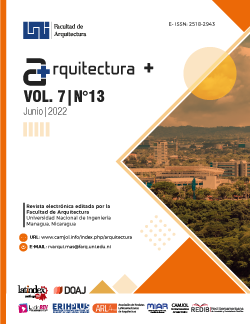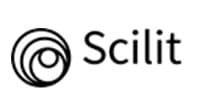The Aqueducts as Heritage. Case Study: Aqueduct of the Hacienda Villa, Lima-Perú
DOI:
https://doi.org/10.5377/arquitectura.v7i13.14435Keywords:
Lima, Aqueduct of the Hacienda de San Juan de Villa, urban context, patrimonial subjects, heritage valuesAbstract
This research aims to contribute to the revaluation of the “Acueducto de San Juan de Villa”; a valuable testimony of colonial hydraulic engineering, including its context and history as well as the heritage object itself, subjects, and current heritage values. Located in the district of Chorrillos, in the proximity of a commercial area, two universities, and the largest swamp in Metropolitan Lima. The objective of this research is to characterize the various heritage values (formal, use, and symbolic) and link them with the subjects who interact directly or indirectly with the aqueduct. Because of this, an in situ investigation of the heritage object is carried out through its planimetric and photographic record at the pedestrian level and with aerial photographs taken from a drone. Precisely in this last point, it is worth mentioning the use of the Structure From Motion (SFM) software, which has allowed the exact three-dimensional reconstruction of its surveyed surfaces to be carried out with photographic shots taken with mid-range cameras. Likewise, the aqueduct is studied using documentary sources such as inventories of monumental heritage, historical aerial photographs, books, magazines, and historical archive publications, and is complemented with interviews with the social actors involved -patrimonial subjects- who give their valuation and the motivations that support them. The main result obtained has been to highlight the views of the different actors on the monument. This mixed research has been taken place during 2021, that is, during the Covid-19 pandemic, for which virtual and face-to-face communication tools had to be combined to overcome the limitations of movement and meeting that this crisis world has imposed.
Downloads
754
References
Asociación Peruana de Empresas de Inteligencia de Mercados. (2018). Distribución de NSE por zona - Lima Metropolitana.
Ausejo, L. (2019). Campus universitario y patrimonio prehispánico dibujando los imaginarios patrimoniales de las huacas de la UNI. Devenir - Revista de estudios sobre patrimonio edificado,6(12), 155-178. Lima, Perú. https://doi.org/10.21754/devenir.v6i12.748
Ballart, J. (1997). El patrimonio histórico y arqueológico: valor y uso. Barcelona: Ariel S.A.
Casasús, A., & Aparici, J. (2017). El patrimonio cultural en educación infantil: Historia, costumbres y tradiciones de la VALL D’UIXÓ. Univeritat Jaume I.
Chacaltana, S. Cogorno G. (2018). Arqueología hidráulica prehispánica del valle bajo del Rímac (Lima, Perú) Estudio de un sistema de riego costeño. Lima: Pontificia Universidad Católica del Perú.
Chang, A. (2020). Patrimonio edificado de la inmigración china en el Centro Histórico de Lima. Devenir - Revista de estudios sobre patrimonio edificado,7(14), 155-172. Lima, Perú. https://doi.org/10.21754/devenir.v7i14.836
Facultad de Arquitectura, Urbanismo y Artes de la Universidad Nacional de Ingeniería (FAUA-UNI)- Fundación Ford. (1994). Inventario del Patrimonio Monumental de Lima. Valles de Chillón, Rímac y Lurín. Lima: Facultad de Arquitectura, Urbanismo y Artes de la Universidad Nacional de Ingeniería.
Feliu, J. (2014). Propuesta para una epistemología del patrimonio. Devenir - Revista de estudios sobre patrimonio edificado,1(2), 10-26. Lima, Perú. https://doi.org/10.21754/devenir.v1i2.233
Fresneda, S. (2008). La Gestión del Patrimonio Cultural. Ponencia de Universidad Sevilla, 9-11.
Flores-Zúñiga, F. (2008). Haciendas y pueblos de Lima: Valle de Sullco y Lati: Ate, La Molina, San Borja, Surco, Miraflores, Barranco y Chorrillos. Lima: Fondo Editorial del Congreso del Perú, Municipalidad Metropolitana.
González, A. (1999). La restauración objetiva (Método SCCM de restauración monumental): memoria SPAL 1993-1998. Barcelona: Diputación de Barcelona.
González, M. (1999). Investigación y puesta en valor del Patrimonio Histórico: Planteamientos y Propuestas desde la Arqueología del Paisaje. (Tesis Doctoral). Universidad Santiago de Compostela, España.
González, D. (2020). Modelo hidráulico virreinal utilizado en el centro histórico de Lima para abastecimiento de agua. Devenir - Revista de estudios sobre patrimonio edificado, 7(14), 91-106. Lima, Perú. https://doi.org/10.21754/devenir.v7i14.811
Hayakawa, J. (2012). Restauro UNI. Breve antología de textos de restauración del patrimonio monumental edificado. Lima: Editorial Universitaria de la Universidad Nacional de Ingeniería.
Hayakawa, J., Anchante, A., Del Castillo, M., Domínguez, S., González, R., Gratelly, I., Vega, S., Muro, F., Paz, P. y Tintaya, A. (2017). El acueducto de la Hacienda Villa, su permanencia en el espacio y tiempo. III Encuentro Nacional de Investigación en Arquitectura y Urbanismo-Facultad de Arquitectura, Urbanismo y Artes, Universidad Nacional de Ingeniería.
Hernández, R., Fernández, C., Baptista, P., (2010) Metodología de la investigación. México. Mc Graw Hill.
Instituto Nacional de Estadística Informática. (2017). Población total proyectada y densidad poblacional, según distrito.
Mechato, F. (2020). Los valores patrimoniales de la unidad vecinal Santa Marina en el Callo desde la mirada de sus residentes y vecinos. Devenir - Revista de estudios sobre patrimonio edificado,7(14), 11-34. Lima, Perú. https://doi.org/10.21754/devenir.v7i14.761
Montañez, M. (2016). Gestión y valoración del patrimonio histórico inmueble en el Centro Histórico del Callao. Devenir - Revista de estudios sobre patrimonio edificado, 3(6), 98-124.Lima, Perú. https://doi.org/10.21754/devenir.v3i6.303
Nieto, C. (2018). La apropiación social como elemento preventivo en la salvaguarda de los bienes culturales. (Tesis doctoral). Valencia, España. Universidad Politécnica de Valencia.
Ortiz, M. (2016). «La ciudad nos agrede”: Gestionando conflictos por el agua en Lima Metropolitana. El caso del canal de riego Surco (2008-2016). (Tesis de licenciatura). Lima, Perú. Pontificia Universidad Católica del Perú.
Vargas Aparicio, E. (2019). Hacer de hombres, vasallos”. La educación en los colegios coloniales antes y después de la expulsión de la Compañía de Jesús del virreinato del Perú, 1767- 1817 (Tesis para optar el grado de Magíster en Historia). http://tesis.pucp.edu.pe/repositorio/bitstream/handle/20.500.12404/15775/VARGAS_APARICIO_HACER_DE_HOMBRES_VASALLOS.pdf?sequence=1&isAllowed=y
Villamón, T. (2017). Reflexiones teóricas contemporáneas sobre patrimonio edificado y su significado. Devenir - Revista de estudios sobre patrimonio edificado,4(8), 123-133. https://doi.org/10.21754/devenir.v4i8.159
Downloads
Published
How to Cite
Issue
Section
License
Copyright (c) 2022 Universidad Nacional de Ingeniería

This work is licensed under a Creative Commons Attribution-NonCommercial-NoDerivatives 4.0 International License.



















